Abstract
Background:
Heat is a harmful factor in workplaces that causes physiologic and cognitive changes in workers.Objectives:
The purpose of this study was to investigate the effect of cooling vest on heat strain and reaction time while wearing chemical-biological-nuclear protective clothes.Methods:
Twelve male students with mean age of 25 ± 2 and body mass index (BMI) of 23 ± 1.5 were recruited in the experiment. Each student ran on a treadmill with a speed of 2.4 km/hour in the climate chamber at 35°C and 30% relative humidity. physiological strain index score, oral temperature, heart rate, reaction time and number of errors were measured at the end of the two levels and analyzed by the SPSS software.Results:
Wilcoxon test showed that the differences of physiological strain index score (P = 0.02), oral temperature (P = 0.02), reaction time (P = 0.02), heart Rate (P = 0.02) and errors (P = 0.03) with and without the cooling vest were significant. The mean physiological strain index score without cooling vest was 4.038 ± 0.882 and with the cooling vest was 1.42 ± 0.435. The mean reaction time without and with the cooling vest was 0.769 ± 0.0972 and 0.539 ± 0.977, respectively.Conclusions:
The results of the study showed that the cooling vest reduces the physiological strain, reaction time and errors rate of workers.Keywords
Heat Strain Reaction Time Physiological Strain Index Cognitive Performance
1. Background
One of the harming factors at work places that initiates physiological strain and lowers the individual’s function is heat (1). The physiological changes caused by heat are called heat strain. Durable exposure to heat not only causes physiological disturbance like muscular craps, heat syncope and heat stroke but also leads to mental impairments (1). These naturally lower work efficiency and increase work place and military accidents (2). In many demanding careers where high amounts of attention is demanded, human inaccuracy can lead to irreversible disasters. In military-related careers and some similar jobs, depending on the climate, geography and the type of military mission, different sorts of clothing are used, which can be roughly divided to two types: fighting and protective clothing. To avoid chemical, biological and nuclear harms as well as physical damages, in special occasions, people are obliged to wear protective gears. Other than being highly protective in the face of environmental threats, they should impose minimum physiological, physical and mental constraints. These gears are very handy in chemical, biological and nuclear invasions as well as emergencies. In the mentioned situations, these gears increase the individuals’ thermal stress and lower their efficiency (3).
Three factors of thermal stress, lowered efficiency and restriction of movement have been introduced in previous studies, such as that of Grugle et al. (4). On the other hand, some other studies have indicated that the level of used energy and the amount of cognitive impairments soared in the case of using such clothing (5-7). Taylor et al. (1993) demonstrated that individuals’ performance declined while using chemical protective gears and the resulting stress kept increasing even in unheated areas (8). In 1986, in the military research facility of the United States, Michael Rauch proved that using chemical protective gears cause cognitive and psychological impairments (5). In 1987, the same researcher carried out a research on chemical protective clothing and stated that wearing chemical protective masks and gloves negatively interferes with problem solving ability (9). Krueger (2001) also reported a 30% reduction in individuals’ function while wearing chemical-biological protective clothing (10).
Various techniques have been tested to reduce the core body temperature, such as floating the whole body in cold water. Although these techniques are practical, they come with certain limitations (11). An operational method for the control of thermal strain in hot places is to supply those working there with cooling gears or cooling vest. During the previous years, several methods have been developed to cool down those infected with diseases or diagnosed with multiple sclerosis (MS), who are intolerant to heat. Differing designs and methods as well as varying technologies have been applied for cooling down. Cooling gears were produced towards the end of the 1950s to protect those working in hot places from heat. These gears were first meant to address the needs of the army or space discoveries but nowadays they are used in various sorts of military and non-military activities (12).
2. Objectives
Regarding the fact that there has been no research investigating chemical-biological-nuclear clothes, the researchers decided to probe the implementation of a cooling vest, designed by the school of health of Isfahan University of Medical Sciences for the reduction of physiological and cognitive strains.
3. Methods
3.1. Participants
Twelve male students of Isfahan Medical School were approved to participate in this study. The recruitment was done based on the procedures of similar studies (13-15). Participants were selected based on having a normal body mass index (BMI) (18.5 - 25), and not having a record of cardiovascular, respiratory, neurological and musculoskeletal diseases as well as epilepsy, seizure and diabetes. The participants were checked for lack of consuming blood pressure medication or medications that affect heart beat rate. They were also controlled for not taking coffee and caffeine 12 hours prior to the test. This was all advised and approved by a physician. Other demographic information like the participants’ age and not having any of the aforementioned diseases were gathered through the questionnaires and participation consent was also obtained from the individuals. The participants’ information is listed in Table 1.
Participants’ Demographic Information (N = 12)
| Characteristic | Mean ± SD | Variable Range |
|---|---|---|
| Age, y | 25 ± 2 | 23 - 29 |
| Height, m | 1.72 ± 0.07 | 1.72 - 1.8 |
| Weight, Kg | 61.8 ± 8.1 | 60 - 80 |
| Body Mass Index (BMI) | 23 ± 1.5 | 21 - 24.9 |
3.2. Clothing
This research implemented protective chemical-biological-nuclear cloths produced by the defense ministry of the Islamic Republic of Iran. The gears were the most recent version of what the military forces were using at the time of this research. The cooling vests produced by the school of health of Isfahan University of Medical Sciences were also examined. The vests included water and paraffin.
3.3. Reaction Time Meter Set
To measure individuals’ reaction time, reaction time meter set of PM-RT16881, produced by Pars Madar, was used. This device shows the individual’s reaction with an accuracy of one millisecond. The device is used to investigate the cognitive situation of the individual when reacting to a stimulus (15). It is also designed in a way that when the stimulus is active, the device starts moving and the individual’s response is stopped. In the present study, two optical signs with different colors and two reaction buttons were given to the participant. Optical stimuli appear in the back of the device where the participant is and the participant is placed in front of it while the device records the reaction and error time, which is displayed on the screen. This test is widely used in psychological studies and has been used in different researches (16, 17).
3.4. Research Protocol
At first, all participants were briefed on how to use the reaction meter device and following a few warm up trials they were all ready. The study was done at 35°C temperature and dry atmosphere, with moisture level of 30% (compatible with general thermal condition of Iran) and the intensity of activity was controlled using a treadmill (Ketler) set on light activity with 2.4 km/hour speed on a 0% slope. Participants were placed in a climate chamber, in which the level of heat and moisture was adjustable, and were tested in two phases. In the first phase, they wore chemical-biological-nuclear gears and in the second phase, both protective gear and cooling vest were worn simultaneously.
Before participants’ wore the gears and entered the climate chamber, their heart-beat (using the Polar sport device), oral temperature (using Brauer oral thermometer made in China), reaction time and its error while resting, were measured. At the end, each of these points was measured again. Activity time in every phase was 20 minutes, which was decided based on the prior-to-the-study pretests so that the heart-beat would not exceed the safe range. Reaction meter device was set in a way to test an individual 25 times in every phase. Each test consisted of two colors and the participants had two buttons, which were to be pressed according to the shown color.
As an example, they were instructed to press the right button when seeing red and the left one when seeing green. Participants were to respond to the shown color as they appeared. In both phases the colors were changed (and not displaced). The reaction time of participants was recorded for all 25 tests and finally the mean was implemented in the statistical analysis. To measure the physiological strain physiological strain index (PSI) was used, which measures the strain based on the heart beat rate and the core body temperature and has a ten-point scale where 0 and 10 stand for no strain and highest amount of strain, respectively. This index is the result of the following formula (18):

In this formula, HRt and Tret represent the simultaneous measuring of heart beat and core body temperature while engaged in an activity. HR0 and Tre0 stand for measures of heart beat and core body temperature while resting (18). At the end we used Wilcoxon and Friedman test in SPSS 20 for data analysis.
4. Results
Wilcoxon test indicated that PSI index with and without the cooling vest had a meaningful (P = 0.002) difference. Differences in reaction time with and without the cooling vest was also meaningful (P = 0.002). This test indicated that the heart beat (P = 0.002) and oral temperature (P = 0.002) with and without the cooling vest were meaningfully different. The mean number of errors without the cooling vest was 2.25 while with the vest it was reduced to 0.5 in all 25 tests and this difference, when applying Wilcoxon test, was meaningful (P = 0.003). The results of the measured variables in two modes of rest, with and without the cooling vest are presented in Table 2. Figures 1-4 also indicate the amount of variable differences in differing modes.
The Results of the Measured Variables
| Variable | Without Cooling Vest | With Cooling Vest | Rest |
|---|---|---|---|
| Reaction time | 0.769 ± 0.0792 | 0.539 ± 0.0977 | 0.541 ± 0.096 |
| Physiological strain index | 4.038 ± 0.882 | 1.42 ± 0.435 | |
| Heart beat | 116.25 ± 8.77 | 103 ± 4.35 | 81.91 ± 4.66 |
| Oral temperature | 37.84 ± 0.36 | 36.65 ± 0.178 | 36.42 ± 0.23 |
| Number of errors | 2.25 ± 0.96 | 0.5 ± 0.647 | 0.5 ± 0.522 |
Also, Freidman test showed that PSI, reaction time, heart-beat, oral temperature and number of errors in three modes of rest, with and without cooling vest were significant (P < 0.001).
Differences of Reaction Time in Three Modes of Rest, with and Without Cooling Vest
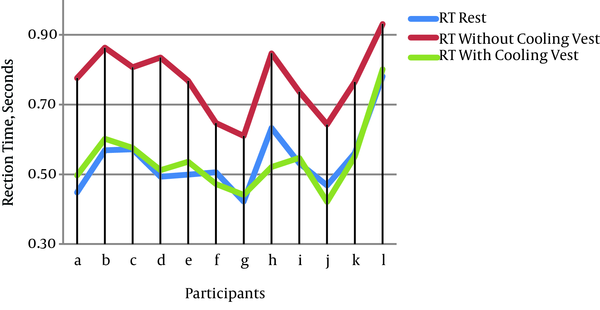
Differences of Heart Beat Rate in Three Modes of Rest, with and Without Cooling Vest
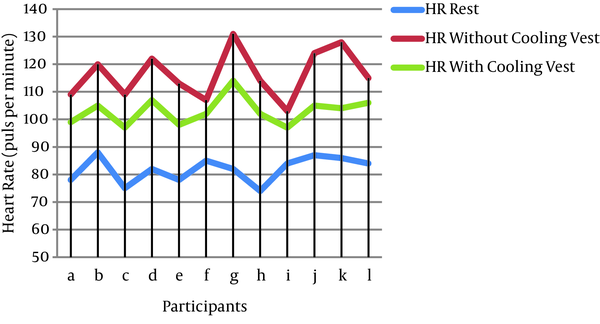
The Difference of Oral Temperature in Three Modes of Rest, with and Without Cooling Vest
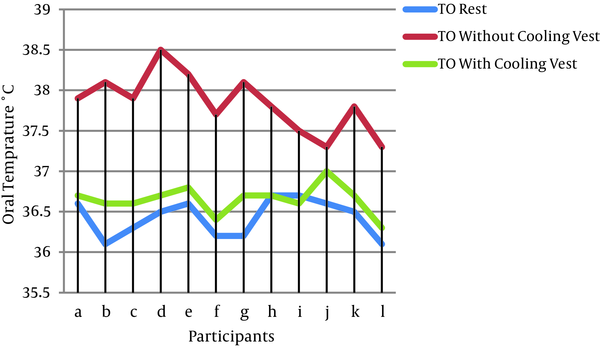
The Difference of the Number of Errors in Three Modes of Rest, with and Without Cooling Vest
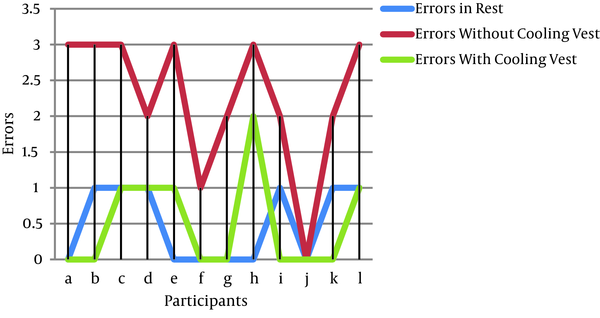
The Difference in Heat Strain Index with and Without Cooling Vest
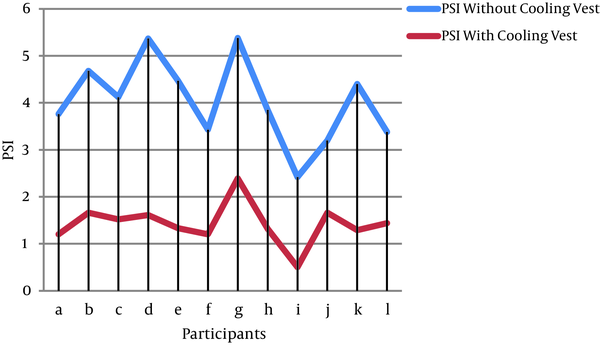
5. Discussion
As the findings of this study indicate, wearing protective clothing and specifically chemical-biological-nuclear gears can have negative physiological and cognitive effects on individuals, which can be controlled through implementing cooling methods.
The present research implemented a cooling vest designed by the school of health of Isfahan University of Medical Sciences, and successfully proved its great effect on reducing cognitive and heat strains. While wearing chemical-biological-nuclear gears in hot conditions, the cooling vest managed to keep the number of errors and oral temperature close to the rest mode and to noticeably reduce the heart-beat and physiological strain index.
In this research, the physiological strain resulted from heat was indicated through the physiological strain index (PSI). This index is measured using two variables of heart beat and core body temperature (18). As indicated by the study results, reducing the physiological strain index leads to a reduction of reaction time. In other words, when the core body temperature is lowered through wearing the cooling vest, physiological strain is also lowered.
Regarding physiology, any physiological disturbance can lead to lowered cognitive and psychological functions (19, 20). Therefore, controlling physiological strains is a way to improve individuals’ cognitive efficiency.
Rauch et al. (1986) indicated that wearing chemical-biological gears negatively affect cognitive function of problem solving (5). In this research, which was done on nine volunteers in the US army, three tests of math computation, pattern recognition and number comparison were implemented to evaluate the cognitive function. The results indicated a lowered problem solving function. At the same line, in 1987, another study was done on the effects of using chemical masks and gloves. This study also implemented the tests of Rauch et al. (1986) and showed that wearing chemical-biological protective masks and gloves distort problem solving ability (9).
Carter et al. (2007) studied the effect of cooling vests in hot places, using a PCM vest and reported that the vests highly reduced the physiological strain of firefighting gear (21). Another study, directed by Gao et al., indicated an intense effect of using cooling vests in reducing heat strain caused by clothing in hot places (22).
In a 2013 study in Germany, Lee et al. implemented body-cooling techniques and managed to improve cognitive efficiency of individuals while having hot cloths on (17). In this study, which was done on 12 volunteers, one of the tests was reaction time that was implemented in the present study as well.
As indicated by previous studies, there are different methods to measure cognitive and mental efficiency. One of these methods that was used in this study was the reaction time test. In 2010, O’Neal et al. used reaction time test to measure cognitive performance of ten workers, who worked in hot environments (23).
It is worth mentioning that measuring rectal temperature, which is implemented in most studies as an index of core body temperature, was not possible. The problem was rectal thermometers being hard to find in Iran’s market and the participants’ reluctance of undergoing such measure. This can be counted as a limitation of this study.
Unfortunately, in Iran, producing protective gears is done without considering the effects of heat strain on the body. As proved by this research as well as other similar studies, heat strain has negative effects on physiological parameters, which in turn lower cognitive efficiency. As a result, when individuals are engaged in military activities or in critical situations, they need to be highly focused and cognitively vigil to control the situation, and their errors can lead to irreparable damages.
5.1. Conclusion
Based on the findings of the research, cooling vests have considerable effect on reducing heat strain, reaction time and error counts of individuals. As protective gears are used in critical situations of a chemical-biological-nuclear invasion, a minute error committed by the person in charge can lead to irreparable damages concerning lives or property. This makes the role of cooling vests very bold and very crucial in restricting such damages. Since, using these cooling vests could be difficult we recommend the use of the designed vest examined in this study for an efficient protective gear.
References
-
1.
Dehghan H, Mortazavi SB, Jafari MJ, Maracy MR. Cardiac Strain between Normal Weight and Overweight Workers in Hot/Humid Weather in the Persian Gulf. Int J Prev Med. 2013;4(10):1147-53. [PubMed ID: 24319554].
-
2.
Adam GE, Carter R, Cheuvront SN, Merullo DJ, Castellani JW, Lieberman HR, et al. Hydration effects on cognitive performance during military tasks in temperate and cold environments. Physiol Behav. 2008;93(4-5):748-56. [PubMed ID: 18166204]. https://doi.org/10.1016/j.physbeh.2007.11.028.
-
3.
Kalyani M, Jamshidi N. Comparing the effect of firefighting protective clothes and usual work clothes during physical activity on heat strain. Pak J Med Sci. 2009;25(3):375-9.
-
4.
Grugle NL, Kleiner BM. Effects of chemical protective equipment on team process performance in small unit rescue operations. Appl Ergon. 2007;38(5):591-600. [PubMed ID: 17049477]. https://doi.org/10.1016/j.apergo.2006.08.003.
-
5.
Rauch TM, Witt C, Banderet L, Tauson R, Golden M. The effects of wearing chemical protective clothing on cognitive problem solving. Natick: Defense Technical Information Center; 1986.
-
6.
Dorman LE, Havenith G. The effects of protective clothing on energy consumption during different activities. Eur J Appl Physiol. 2009;105(3):463-70. [PubMed ID: 19011890]. https://doi.org/10.1007/s00421-008-0924-2.
-
7.
Faff J, Tutak T. Physiological responses to working with fire fighting equipment in the heat in relation to subjective fatigue. Ergonomics. 1989;32(6):629-38. [PubMed ID: 2776742]. https://doi.org/10.1080/00140138908966137.
-
8.
Taylor HL, Orlansky J. The effects of wearing protective chemical warfare combat clothing on human performance. Aviat Space Environ Med. 1991;64(3):1-41. https://doi.org/10.1037/e530602006-001.
-
9.
Rauch TM, Tharion WJ. The effects of wearing the chemical protective mask and gloves on cognitive problem solving. Natick: Defense Technical Information Center; 1987.
-
10.
Krueger GP. Psychological and performance effects of chemical-biological protective clothing and equipment. Mil Med. 2001;166(12 Suppl):41-3. [PubMed ID: 11778430].
-
11.
Fujii RK, Horie S, Tsutsui T, Nagano C. Effectiveness of a head wash cooling protocol using non-refrigerated water in reducing heat stress. J Occup Health. 2008;50(3):251-61. [PubMed ID: 18413974].
-
12.
Branson DH, Cao H, Jin B, Peksoz S, Farr C, Ashdown S. Fit Analysis of Liquid Cooled Vest Prototypes Using 3D Body Scanning Technology. U.S: Cornell University; 2005.
-
13.
Kakitsuba N. Dynamic changes in sweat rates and evaporation rates through clothing during hot exposure. J Therm Biol. 2004;29(7-8):739-42. https://doi.org/10.1016/j.jtherbio.2004.08.048.
-
14.
Ashley CD, Luecke CL, Schwartz SS, Islam MZ, Bernard TE. Heat strain at the critical WBGT and the effects of gender, clothing and metabolic rate. Int J Indus Ergo. 2008;38(7-8):640-4. https://doi.org/10.1016/j.ergon.2008.01.017.
-
15.
Schouten JF, Bekker JA. Reaction time and accuracy. Acta Psychol (Amst). 1967;27:143-53. [PubMed ID: 6062205].
-
16.
Weiss AD. The Locus of Reaction Time Change with Set, Motivation, and Age. J Gerontol. 1965;20:60-4. [PubMed ID: 14246532].
-
17.
Lee JK, Koh AC, Koh SX, Liu GJ, Nio AQ, Fan PW. Neck cooling and cognitive performance following exercise-induced hyperthermia. Eur J Appl Physiol. 2014;114(2):375-84. [PubMed ID: 24318656]. https://doi.org/10.1007/s00421-013-2774-9.
-
18.
Moran DS, Shitzer A, Pandolf KB. A physiological strain index to evaluate heat stress. Am J Physiol Regul Integr Comp Physiol. 1998;275(1):129-34.
-
19.
Hocking C, Silberstein RB, Lau WM, Stough C, Roberts W. Evaluation of cognitive performance in the heat by functional brain imaging and psychometric testing. Comp Biochem Physiol A Mol Integr Physiol. 2001;128(4):719-34. https://doi.org/10.1016/s1095-6433(01)00278-1.
-
20.
Hancock PA, Vasmatzidis I. Effects of heat stress on cognitive performance: the current state of knowledge. Int J Hyperthermia. 2003;19(3):355-72. [PubMed ID: 12745975]. https://doi.org/10.1080/0265673021000054630.
-
21.
Carter JM, Rayson MP, Wilkinson DM, Richmond V, Blacker S. Strategies to combat heat strain during and after firefighting. J ThermBiolo. 2007;32(2):109-16. https://doi.org/10.1016/j.jtherbio.2006.12.001.
-
22.
Gao C, Kuklane K, Holmér I. Cooling effect of a PCM vest on a thermal manikin and on humans exposed to heat. in 12th International Conference on Environmental Ergonomics. Ljubljana: Biomed doo; 2007.
-
23.
O'Neal EK, Bishop P. Effects of work in a hot environment on repeated performances of multiple types of simple mental tasks. Int J Ind Ergonom. 2010;40(1):77-81. https://doi.org/10.1016/j.ergon.2009.07.002.